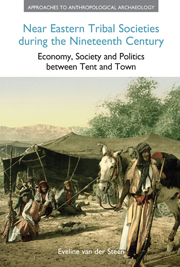 Near Eastern Tribal Societies during the Nineteenth Century
Near Eastern Tribal Societies during the Nineteenth Century What noble family, but springs from a captain among robbers? Trade alone can spoil our blood; robbery purifies it. The robbery of one age is the chivalry of the next. We may start anew, and vie with even the nobility of France, if we can once enrol but half the Doones upon our lineage.
(R. D. Blackmore, Lorna Doone, 1869)Introduction
As stated in Chapter 1, asabiyyeh, the sense of belonging, plays a dominant role in the concept of tribe. Asabiyyah is a determining factor in the ideology and in the daily life and actions of tribes. It defines how they see the concept of territory. It is instrumental in the glorious deeds of tribal heroes and determines the purpose of tribal history. Western travellers found this group ethic either baffling or were drawn to it, particularly in the second half of the nineteenth century, with its Victorian spirit that valued private enterprise and personal aspiration above all.
The various tribal institutions, such as the leadership, protection, raiding and hospitality, are all determined by the concept of asabiyyah. This chapter provides a closer look at these tribal institutions and how they are geared towards protection and advancement of the group as a whole.
To save this book to your Kindle, first ensure [email protected] is added to your Approved Personal Document E-mail List under your Personal Document Settings on the Manage Your Content and Devices page of your Amazon account. Then enter the ‘name’ part of your Kindle email address below. Find out more about saving to your Kindle.
Note you can select to save to either the @free.kindle.com or @kindle.com variations. ‘@free.kindle.com’ emails are free but can only be saved to your device when it is connected to wi-fi. ‘@kindle.com’ emails can be delivered even when you are not connected to wi-fi, but note that service fees apply.
Find out more about the Kindle Personal Document Service.
To save content items to your account, please confirm that you agree to abide by our usage policies. If this is the first time you use this feature, you will be asked to authorise Cambridge Core to connect with your account. Find out more about saving content to Dropbox.
To save content items to your account, please confirm that you agree to abide by our usage policies. If this is the first time you use this feature, you will be asked to authorise Cambridge Core to connect with your account. Find out more about saving content to Google Drive.